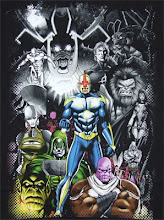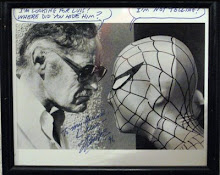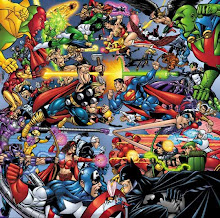Superheroes were returning, DC comics had the first superhero publications that had real success at the 60’s, publications like green lantern, flash and the justice league. But Marvel Comics (name granted to the company at the late 50’s) did a lot of strategic moves and publications; they took the Fantastic Four, a comic where four powerless friends had adventures in the cold war years, and gave them super powers by sending them to a life-changing space trip. This move plus the publication of big hit comics like Spiderman, Hulk, Iron-man, the X-men, Ant-man and Thor made the publishing house right back in the top. The  new publications had new ideas like the idea of giving the heroes secret identities and showing how tuff was the “real life” for them making the readers, mostly teenager really sympathize with the characters (specially Spiderman who was a not wealthy young boy having normal life troubles and superhero troubles), these new ideas, besides reconnecting the hero movement to the market, made these comics what are they now. Comparing the classic comic dispute between Marvel and DC comics with the movie business, comic writer Peter Sanderson wrote:
new publications had new ideas like the idea of giving the heroes secret identities and showing how tuff was the “real life” for them making the readers, mostly teenager really sympathize with the characters (specially Spiderman who was a not wealthy young boy having normal life troubles and superhero troubles), these new ideas, besides reconnecting the hero movement to the market, made these comics what are they now. Comparing the classic comic dispute between Marvel and DC comics with the movie business, comic writer Peter Sanderson wrote:
“DC was the equivalent of the big Hollywood studios: after the brilliance of DC's reinvention of the superhero ... in the late 1950s and early 1960s, it had run into a creative drought by the decade's end. There was a new audience for comics now, and it wasn't just the little kids that traditionally had read the books. The Marvel of the 1960s was in its own way the counterpart of the French new wave.... Marvel was pioneering new methods of comics storytelling and characterization, addressing more serious themes, and in the process keeping and attracting readers in their teens and beyond. Moreover, among this new generation of readers were people who wanted to write or draw comics themselves, within the new style that Marvel had pioneered, and push the creative envelope still further”
The 60’s where the silver age for the comic business. Marvel was in its best years since the 40’s and now the publishing company had the most talented artists and writers who gave to it their best superheroes. There were three special artists/writers who became legend in the business and help Marvel to have the real touch that DC comics found later and with many trouble. These legends were: Jack Kirby, Stan Lee, and Steve Ditko the first one was know as the “natural superhero drawer”, the second one was know for his skills with the story sense and for it ability to choose very talented staff and for organizing very good creative teams, the third one was know because he gave the real touch to the stories. In 1968 marvel founder, Martin Goodman sold the publishing house, but he still was the main publisher and Marvel Comics still had its soul with publications as big as the avengers, the comic that reunited almost every Marvel superhero and showed their adventures.
legends were: Jack Kirby, Stan Lee, and Steve Ditko the first one was know as the “natural superhero drawer”, the second one was know for his skills with the story sense and for it ability to choose very talented staff and for organizing very good creative teams, the third one was know because he gave the real touch to the stories. In 1968 marvel founder, Martin Goodman sold the publishing house, but he still was the main publisher and Marvel Comics still had its soul with publications as big as the avengers, the comic that reunited almost every Marvel superhero and showed their adventures.
 new publications had new ideas like the idea of giving the heroes secret identities and showing how tuff was the “real life” for them making the readers, mostly teenager really sympathize with the characters (specially Spiderman who was a not wealthy young boy having normal life troubles and superhero troubles), these new ideas, besides reconnecting the hero movement to the market, made these comics what are they now. Comparing the classic comic dispute between Marvel and DC comics with the movie business, comic writer Peter Sanderson wrote:
new publications had new ideas like the idea of giving the heroes secret identities and showing how tuff was the “real life” for them making the readers, mostly teenager really sympathize with the characters (specially Spiderman who was a not wealthy young boy having normal life troubles and superhero troubles), these new ideas, besides reconnecting the hero movement to the market, made these comics what are they now. Comparing the classic comic dispute between Marvel and DC comics with the movie business, comic writer Peter Sanderson wrote:“DC was the equivalent of the big Hollywood studios: after the brilliance of DC's reinvention of the superhero ... in the late 1950s and early 1960s, it had run into a creative drought by the decade's end. There was a new audience for comics now, and it wasn't just the little kids that traditionally had read the books. The Marvel of the 1960s was in its own way the counterpart of the French new wave.... Marvel was pioneering new methods of comics storytelling and characterization, addressing more serious themes, and in the process keeping and attracting readers in their teens and beyond. Moreover, among this new generation of readers were people who wanted to write or draw comics themselves, within the new style that Marvel had pioneered, and push the creative envelope still further”
The 60’s where the silver age for the comic business. Marvel was in its best years since the 40’s and now the publishing company had the most talented artists and writers who gave to it their best superheroes. There were three special artists/writers who became legend in the business and help Marvel to have the real touch that DC comics found later and with many trouble. These
 legends were: Jack Kirby, Stan Lee, and Steve Ditko the first one was know as the “natural superhero drawer”, the second one was know for his skills with the story sense and for it ability to choose very talented staff and for organizing very good creative teams, the third one was know because he gave the real touch to the stories. In 1968 marvel founder, Martin Goodman sold the publishing house, but he still was the main publisher and Marvel Comics still had its soul with publications as big as the avengers, the comic that reunited almost every Marvel superhero and showed their adventures.
legends were: Jack Kirby, Stan Lee, and Steve Ditko the first one was know as the “natural superhero drawer”, the second one was know for his skills with the story sense and for it ability to choose very talented staff and for organizing very good creative teams, the third one was know because he gave the real touch to the stories. In 1968 marvel founder, Martin Goodman sold the publishing house, but he still was the main publisher and Marvel Comics still had its soul with publications as big as the avengers, the comic that reunited almost every Marvel superhero and showed their adventures.




